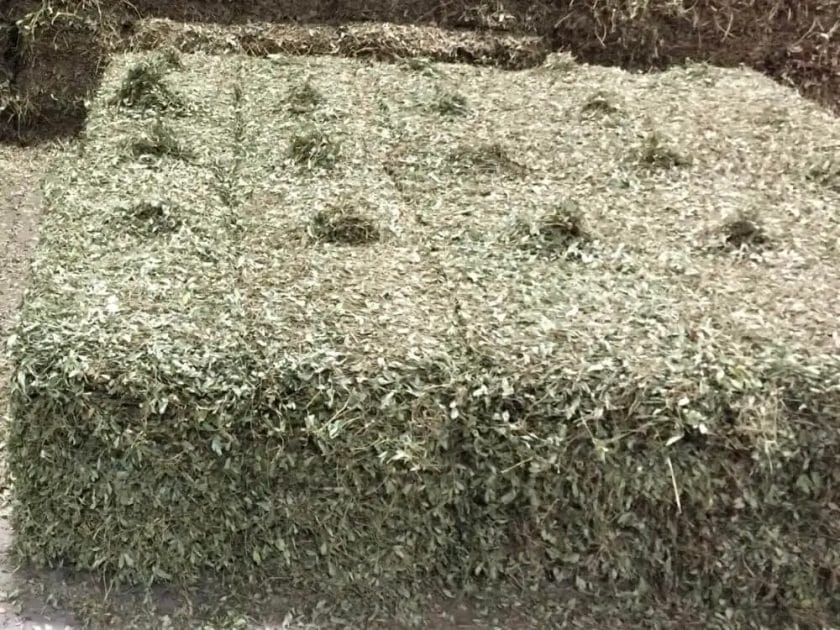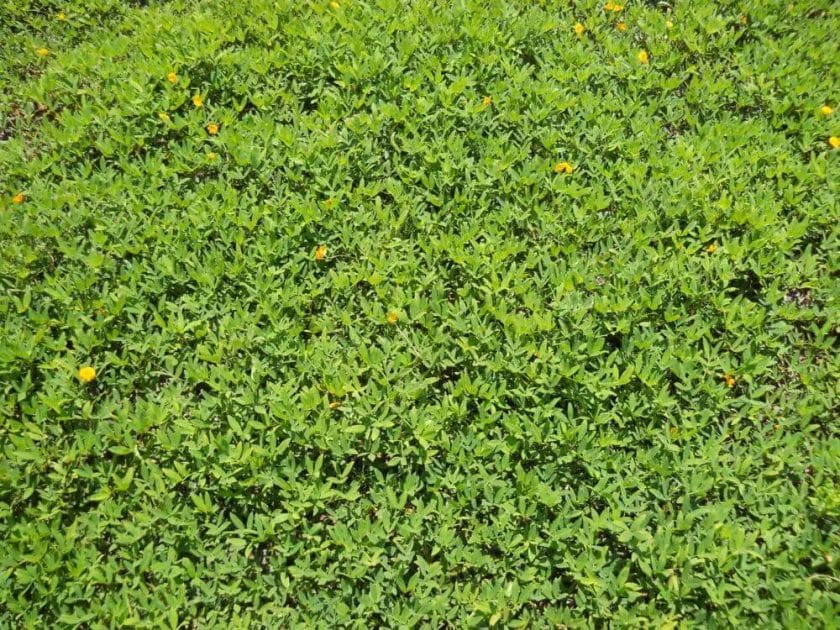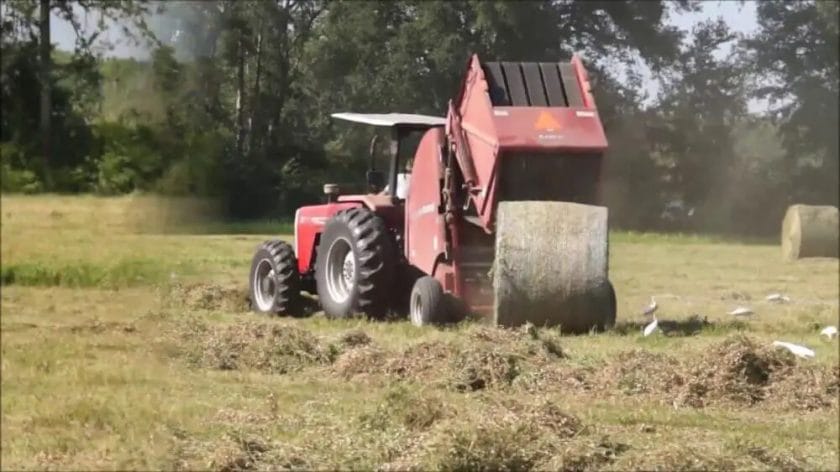Peanut hay is a nutritious and beneficial feed option for horses. With its high protein content and digestibility, peanut hay provides essential nutrients needed for optimal horse health. It is a suitable alternative to traditional grass or alfalfa hay, especially for horses with specific dietary requirements or those needing extra protein for muscle development. Additionally, the low sugar content of peanut hay makes it an ideal choice for horses that are prone to metabolic issues or insulin resistance. Add peanut hay to your horse’s diet for a wholesome and balanced feed option.

Nutritional Content of Peanut Hay for Horses
When it comes to feeding horses, hay plays a crucial role in providing essential nutrients. While traditional hays like timothy or alfalfa are commonly used, peanut hay has gained popularity as an alternative option. But what exactly is the nutritional content of peanut hay for horses?
Protein: Peanut hay is known for its high protein content, making it a valuable feed option for horses. On average, peanut hay contains around 15-20% protein, which is higher than most other types of hay. This protein content is beneficial for horses, especially those in need of additional muscle development or recuperation from an injury.
Fiber: Fiber is an essential component of a horse’s diet, aiding in digestion and overall gut health. Peanut hay offers a good amount of fiber, typically ranging from 25-30%. This fiber content helps regulate a horse’s digestive system, preventing issues like colic and ensuring optimal nutrient absorption.
Fat: Peanut hay contains a moderate amount of fat compared to other hays. The fat content varies depending on factors such as the maturity of the peanut plants at harvest. On average, peanut hay has a fat content of around 2-3%. While not a significant source of fat, it still contributes to a horse’s calorie intake.
Calcium and Phosphorus: Calcium and phosphorus are essential minerals for maintaining healthy bones, teeth, and overall body function in horses. Peanut hay generally has a balanced ratio of calcium and phosphorus, making it a suitable option for maintaining proper mineral levels in a horse’s diet.
Vitamins and Minerals: Peanut hay is a good source of various vitamins and minerals necessary for a horse’s overall health. It contains vitamins A, E, and K, which are vital for immune function, vision, and blood clotting. Additionally, it provides minerals such as potassium, magnesium, and zinc, which play crucial roles in muscle function, nerve transmission, and nutrient metabolism.
Feeding Recommendations: While peanut hay offers numerous nutritional benefits, it’s important to consider a horse’s individual needs and dietary requirements. It is advisable to consult with a veterinarian or equine nutritionist to determine the appropriate amount of peanut hay to feed your horse based on its age, weight, activity level, and overall health.
Conclusion:
In summary, peanut hay provides a rich nutritional profile for horses. With its high protein content, adequate fiber levels, and essential vitamins and minerals, it can serve as a valuable addition to a horse’s diet. However, it’s crucial to consider individual horse requirements and consult with professionals to ensure optimal feeding practices.

How to Incorporate Peanut Hay into a Horse’s Diet
Peanut hay can be a nutritious addition to a horse’s diet, providing valuable nutrients and fiber. However, it’s important to incorporate it gradually and in the right proportions to ensure the horse’s health and well-being. Here are some guidelines on how to incorporate peanut hay into a horse’s diet:
1. Introduce Peanut Hay Gradually
When introducing peanut hay to a horse’s diet, it’s crucial to do it gradually. Start by adding small amounts of peanut hay to their regular forage, such as grass hay or alfalfa. This helps the horse adjust to the new feed and prevents any digestive issues that sudden dietary changes can cause. Gradually increase the amount of peanut hay over a period of one to two weeks.
2. Monitor the Horse’s Digestion
As you incorporate peanut hay into the horse’s diet, closely monitor their digestion. Observe their manure consistency, appetite, and overall well-being. Any drastic changes or concerns should be discussed with a veterinarian. It’s important to ensure that the horse is properly digesting and utilizing the nutrients from the peanut hay.
3. Balance the Nutritional Content
While peanut hay is a good source of fiber and protein, it’s essential to balance its nutritional content with other feeds. Horses require a well-rounded diet that includes carbohydrates, fats, vitamins, and minerals. Consult with a qualified equine nutritionist to develop a balanced diet plan that incorporates peanut hay along with other necessary nutrients.
4. Consider the Horse’s Individual Needs
Each horse has unique dietary needs based on their age, activity level, and overall health. When incorporating peanut hay, consider these individual needs. Young horses, pregnant or lactating mares, and horses in heavy work may require a different feeding plan compared to older, sedentary horses. Tailor the amount of peanut hay and other feeds accordingly.
5. Provide Ample Fresh Water
When feeding peanut hay or any other type of forage, ensure that the horse has access to fresh, clean water at all times. This helps with digestion and overall hydration. Adequate water intake is crucial for a horse’s overall health and well-being.
6. Regularly Evaluate the Horse’s Condition
Continuously evaluate the horse’s body condition and overall appearance to determine if adjustments are needed in their diet. If the horse is gaining or losing weight, showing signs of malnutrition, or experiencing any health issues, consult with a veterinarian or equine nutritionist to make the necessary dietary changes.
7. Watch for Allergies or Sensitivities
While peanut hay is generally safe for horses, some individuals may have allergies or sensitivities to peanuts. Monitor the horse for any signs of allergic reactions, such as skin irritation, breathing difficulties, or gastrointestinal distress. If any adverse reactions occur, discontinue the use of peanut hay and consult a veterinarian.
In summary, incorporating peanut hay into a horse’s diet can be beneficial, but it should be done gradually and in moderation. Monitoring the horse’s digestion, balancing the nutritional content, considering individual needs, providing ample water, regularly evaluating the horse’s condition, and watching for allergies or sensitivities are essential steps in incorporating peanut hay into a horse’s diet. Consult with a professional equine nutritionist or veterinarian for personalized advice and guidance.

Potential Risks and Precautions of Feeding Horses Peanut Hay
While peanut hay can be a nutritious and cost-effective option for feeding horses, it is important for horse owners and caretakers to be aware of the potential risks and take necessary precautions. Here are some of the potential risks associated with feeding horses peanut hay:
1. Allergic Reactions
Horses, just like humans, can develop allergies to certain foods. Some horses may be allergic to peanuts or peanut products, including peanut hay. Allergic reactions can range from mild, such as skin irritation and itching, to severe, such as respiratory distress or anaphylactic shock. If your horse has a known allergy to peanuts, it is best to avoid feeding them peanut hay altogether.
2. Aflatoxin Contamination
Aflatoxins are toxic substances produced by certain molds, particularly Aspergillus flavus and Aspergillus parasiticus. These molds can grow on crops, including peanuts, especially in warm and humid conditions. Aflatoxin-contaminated peanut hay can pose a serious health risk to horses if ingested. It is important to source peanut hay from reputable suppliers and carefully inspect the quality of the hay before feeding it to your horses. Regular testing for aflatoxin levels is recommended to ensure the safety of the hay.
3. Digestive Upsets
Peanut hay has a higher fat content compared to other types of hay. While this can be beneficial for certain horses, it may also increase the risk of digestive upsets, especially if the horse’s diet is not properly balanced. Horses with sensitive digestive systems or those prone to conditions like colic or laminitis may be particularly susceptible to digestive issues when fed peanut hay. It is important to introduce peanut hay gradually and monitor your horse’s response to avoid any digestive disturbances.
4. Nutrient Imbalances
Peanut hay has a different nutrient profile compared to traditional grass hay. It tends to have higher levels of protein and calories, as well as lower levels of calcium and phosphorus. Feeding peanut hay as the sole forage source without balancing the diet with appropriate supplements or additional forage can lead to nutrient imbalances and potential health issues. It is important to consult with a qualified equine nutritionist to create a well-balanced diet plan if peanut hay is a significant part of your horse’s forage intake.
5. Physical Hazards
When feeding peanut hay, there is a risk of physical hazards such as mold spores, dust, and foreign objects. It is crucial to properly store peanut hay in a dry and well-ventilated area to minimize the growth of molds. Before feeding, inspect the hay for any signs of mold, pests, or foreign objects, and remove them as necessary. Soaking the hay can help reduce dust and make it more palatable for some horses.
In summary, while peanut hay can be a beneficial feed option for horses, it is important to be aware of the potential risks and take necessary precautions. Allergic reactions, aflatoxin contamination, digestive upsets, nutrient imbalances, and physical hazards are some of the factors to consider when feeding horses peanut hay. By sourcing high-quality hay, gradually introducing it to the horse’s diet, and ensuring a balanced overall diet, horse owners can minimize the risks associated with feeding their horses peanut hay.
Comparing Peanut Hay to Other Forage Options for Horses
When it comes to providing forage options for horses, there are several choices available. One of these options is peanut hay, which is gaining popularity among horse owners. In this section, we will compare peanut hay to other forage options commonly fed to horses, such as grass hay and alfalfa hay.
1. Nutritional Value
Peanut hay is known for its high nutritional value, making it a great choice for horses. It is rich in protein, with levels comparable to alfalfa hay. Additionally, peanut hay has a favorable calcium-to-phosphorus ratio, which is essential for maintaining a horse’s overall health. Grass hay, on the other hand, tends to be lower in protein and may not provide the same level of nutrition as peanut hay or alfalfa hay.
2. Digestibility
When it comes to digestibility, peanut hay is highly regarded. It is easily digested by horses and can be an excellent option for those with digestive sensitivities. Grass hay, although commonly fed to horses, may be less digestible for some individuals. Alfalfa hay is also highly digestible, making it another viable option.
3. Palatability
Palatability is an essential factor when selecting forage options for horses. Peanut hay is known for its sweet taste, which is often appealing to horses. This makes it a desirable choice for picky eaters. Grass hay and alfalfa hay also have their own palatability advantages, but it ultimately depends on the horse’s preferences.
4. Price and Availability
When considering forage options, price and availability are crucial factors to consider. Peanut hay may be slightly more expensive compared to grass hay, but it can vary depending on the region and availability. Alfalfa hay is generally more expensive than peanut hay. Availability can also vary depending on the location, as not all areas may have access to peanut hay.
5. Allergies and Sensitivities
Horses can have allergies or sensitivities to certain types of forage. Peanut hay, although generally well-tolerated, can potentially cause an allergic reaction in some horses. Grass hay and alfalfa hay may also have their own set of allergenic properties. It is crucial to observe any adverse reactions when introducing a new forage option to a horse’s diet.
In summary, peanut hay is a highly nutritious forage option for horses, comparable to alfalfa hay in terms of protein content. It is highly digestible and has excellent palatability. However, its availability and potential allergenic properties should be taken into consideration. Grass hay and alfalfa hay also have their advantages and can be suitable options based on individual horse preferences and needs. When selecting a forage option for horses, it is important to consider the nutritional value, digestibility, palatability, price, availability, and any potential allergies or sensitivities.
FAQs
Is peanut hay good for horses?
Yes, peanut hay can be a suitable feed option for horses. It is high in fiber and protein, and can provide essential nutrients. However, it should be fed in moderation, as excessive consumption can lead to weight gain or digestive issues. It is recommended to consult with a veterinarian or equine nutritionist to determine the appropriate amount for your horse.
Conclusion
In conclusion, peanut hay can be a beneficial feed option for horses. It is a nutritious forage with high protein content, making it ideal for horses that require additional protein in their diet. Additionally, peanut hay can help prevent digestive issues such as colic and ulcers due to its high fiber content. The inclusion of peanut hay in the horse’s diet can also contribute to improved overall health and performance. However, it is important to introduce peanut hay gradually to the horse’s diet and monitor for any adverse reactions. Consulting with a veterinarian or equine nutritionist is recommended to ensure the proper integration of peanut hay into the horse’s feeding program.
